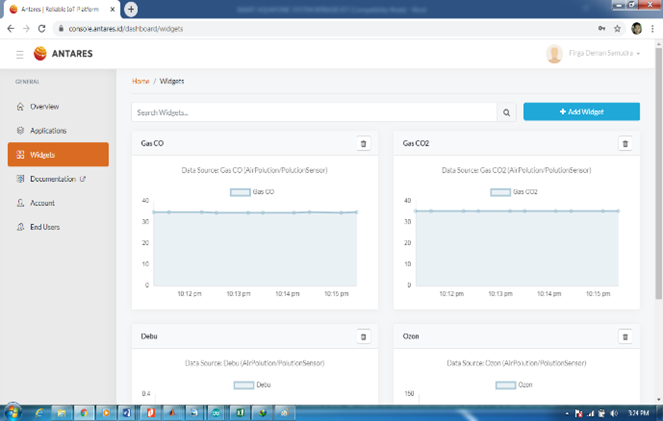Air Pullution Monitoring and Detection System Design Using Fuzzy Method Based on IoT
Perancangan Sistem Monitoring dan Deteksi Polusi Udara Menggunakan Metode Fuzzy Sugeno Berbasis IoT
DOI:
https://doi.org/10.21070/joincs.v4i1.1580Keywords:
Air quality, harmful pollutants, detect, monitor, Internet of ThingsAbstract
The large amount of air pollution that occurs in the community is caused by the increase in the number of motorized vehicles and human activities, as well as the limited sense of sight and smell of humans so that they cannot feel the presence of pollutant gases that are harmful to health, so we need a tool that can detect and monitor pollutant gases so they don't exceed the threshold. In this study, a monitoring system and air pollution detection using the fuzzy Sugeno method based on the Internet of Things (IoT) is designed. In this system the MQ-7, MQ-135 and MQ-131 sensors are used to detect CO, CO2 and Ozone gases, while the Sharp GP2Y1010AU0F sensor functions to detect dust. The results of these sensor readings are processed by the Arduino Uno and NodeMCU microcontrollers to be displayed on the P10 panel and sent to the Antares IoT Cloud server which can be accessed in real time. The results of this study have an accuracy rate of approximately 97% for gas sensors, both CO, CO2, and Ozone gas sensors. As for the dust sensor, the accuracy rate is 93.83%.
References
[2] R. N. Lesmana dan Y. Rahayu, “Membangun Sistem Pemantau Kualitas Udara Dalam Ruangan Dengan Mengaplikasikan Sensor CO Berbasis LabVIEW,” Jom FTEKNIK, vol. 3, hal. 1–6, 2016.
[3] J. Abidin, F. Artauli Hasibuan, K. kunci, P. Udara, dan D. Gauss, “Pengaruh Dampak Pencemaran Udara Terhadap Kesehatan Untuk Menambah Pemahaman Masyarakat Awam Tentang Bahaya Dari Polusi Udara,” Pros. SNFUR-4, no. September, hal. 978–979, 2019.
[4] Kementerian Lingkungan Hidup Dan Kehutanan Republik Indonesia, “Peraturan Menteri Lingkungan Hidup Dan Kehutanan Republik Indonesia Nomor 14 Tahun 2020 Tentang Indeks Standar Pencemar Udara,” hal. 1–16, 2020.
[5] Y. Efendi, “Internet Of Things (Iot) Sistem Pengendalian Lampu Menggunakan Raspberry Pi Berbasis Mobile,” J. Ilm. Ilmu Komput., vol. 4, no. 1, hal. 19–26, 2018.
[6] R. Wulandari, “ANALISIS QoS (QUALITY OF SERVICE) PADA JARINGAN INTERNET (STUDI KASUS : UPT LOKA UJI TEKNIK PENAMBANGAN JAMPANG KULON – LIPI),” J. Tek. Inform. dan Sist. Inf., vol. 2, no. 2, hal. 162–172, 2016.
[7] L. Salisa Setiawati, I. Budiman, dan O. Soesanto, “Penerapan Fuzzy Inference System Takagi-Sugeno-Kang pada Sistem Pakar Diagnosa Penyakit Gigi,” J. Ilmu Komput., vol. 04, no. 01, hal. 1–10, 2016.
proving Text Preprocessing for Student Complaint Document Classification Using Sastrawi,” IOP Conf. Ser. Mater. Sci. Eng., vol. 874, no. 1, 2020.
[2] R. Kiran, P. Kumar, and B. Bhasker, “Oslcfit (organic simultaneous LSTM and CNN Fit): A novel deep learning based solution for sentiment polarity classification of reviews,” Expert Syst. Appl., vol. 157, p. 113488, 2020.






